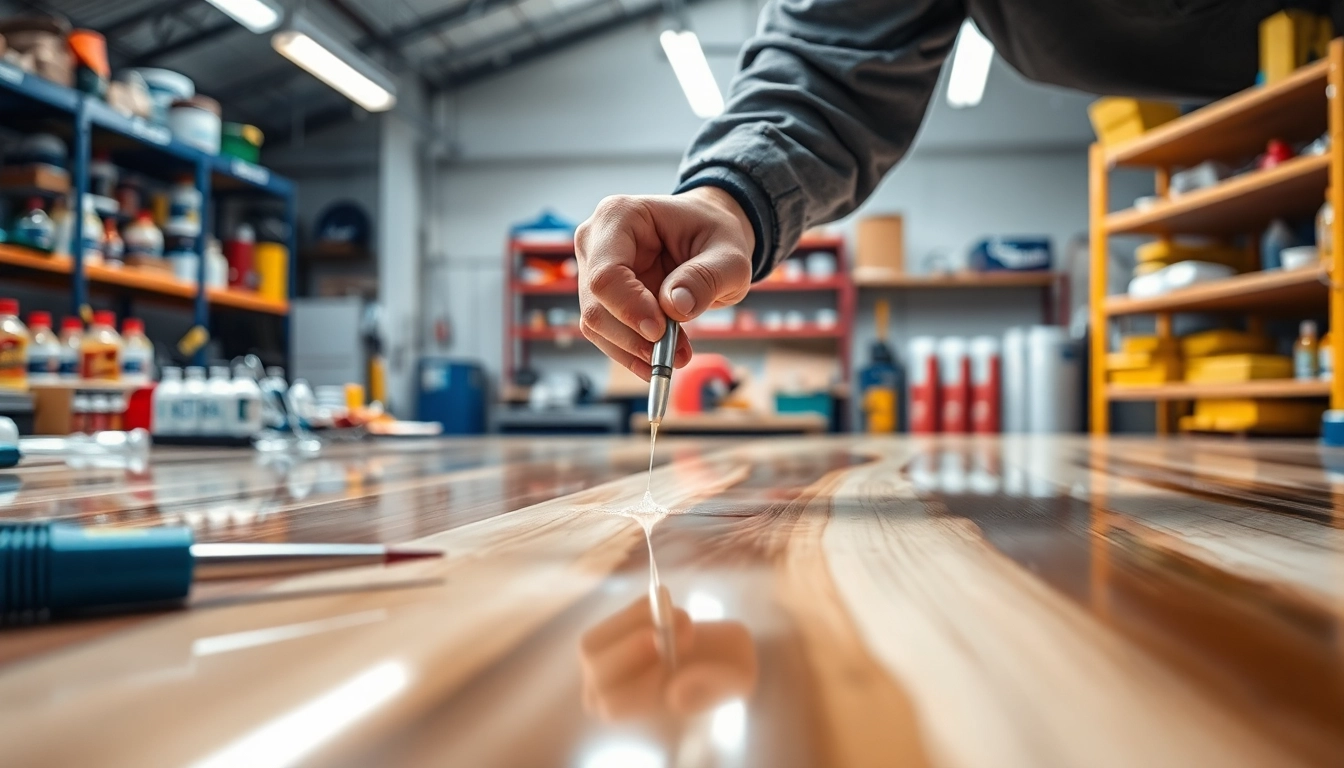Understanding Laminating Resin
What is Laminating Resin?
Laminating resin is a crucial material in composite manufacturing, particularly known for its role in creating layered structures using fibrous reinforcements such as fiberglass, carbon fiber, or aramid fibers. This resin serves as an adhesive agent that binds the layers together, providing strength, durability, and resistance to environmental factors. Laminating resins are generally thermosetting, meaning they cure through a chemical reaction and maintain their shape and strength after being applied and set. This property makes them particularly well-suited for applications in marine, automotive, and construction industries where structural integrity is paramount.
Types of Laminating Resins
Two primary types of laminating resins are widely used: polyester and epoxy. Each has unique characteristics that cater to different applications.
- Polyester Laminating Resin: This type is widely favored due to its ease of use and cost-effectiveness. It offers good adhesion and is suitable for applications where high strength is not the primary requirement. It cures quickly and is typically applied in marine applications, particularly in boat construction.
- Epoxy Laminating Resin: Known for superior mechanical properties, epoxy resins provide excellent adhesion, chemical resistance, and durability. They are ideal for high-performance applications, including aerospace and high-end automotive uses, where weight-to-strength ratios are critical.
Key Features of Laminating Resin
When considering laminating resin, several key features define its performance and suitability for specific applications:
- Viscosity: This affects how well the resin can wet out the reinforcement materials. Low-viscosity resins flow easily and saturate fibers thoroughly, which is vital for maintaining structural integrity.
- Cure Time: Fast curing resins enable quicker production cycles, while slower curing options allow more working time for application.
- Flexural Strength: High flexural strength indicates the ability to withstand bending without failure, crucial for structural components.
- Thermal Resistance: The resistance to deformation and breakdown at elevated temperatures is essential in applications exposed to heat.
Applications of Laminating Resin
Common Uses in Marine Industry
The marine industry extensively utilizes laminating resins, primarily for constructing boats and other watercraft. The hydrophobic nature of laminated structures aids in water resistance, while the durability ensures longevity in harsh conditions. Laminating resin is instrumental in creating hulls, decks, and inner structures where strength and rigidity are essential.
Significance in Composite Materials
In the realm of composite manufacturing, laminating resin is central to creating materials that outperform traditional materials. By layering fibers with resin, manufacturers can design composite structures that exhibit desirable properties like reduced weight and enhanced mechanical performance. A prime example can be seen in industries such as aerospace, where composite wings and fuselage components are constructed using laminating resins to achieve efficient fuel performance and robustness.
Benefits for Artistic Projects
Artists and hobbyists have increasingly adopted laminating resin for various projects, including sculpture making and crafting custom designs. The ability to create high-gloss finishes and encapsulate materials allows for innovative artistic expression. Laminating resin enables artists to embed objects or create intricate designs while providing a protective layer that sustains the aesthetic appeal of their work.
Choosing the Right Laminating Resin
Criteria for Selecting Laminating Resin
Choosing the appropriate laminating resin involves evaluating several factors:
- Project Requirements: Consider the mechanical, thermal, and aesthetic requirements of your project. High-stress applications might necessitate epoxy resins, whereas general fabrications can benefit from polyester options.
- Curing Conditions: Evaluate the conditions under which the resin will cure. Temperature and humidity can significantly affect the curing process, impacting the final product’s performance.
- Compatibility with Reinforcement Materials: Ensure that the selected resin effectively bonds with the reinforcement materials being used. Compatibility plays a crucial role in achieving desired strength and durability.
Comparing Laminating Resin Options
When comparing laminating resin options, it’s essential to analyze their specific attributes:
- Cost: While epoxy resins may offer superior performance, they also tend to be more expensive than polyester options. A thorough cost analysis against performance benefits should be conducted.
- Workability: Evaluate how easy the resin is to mix and apply. Certain formulations might require specialized handling or application techniques.
- Post-Cure Characteristics: Understanding how the resin behaves post-cure, including flexibility, hardness, and durability, will help in selecting the most appropriate type for the application.
Cost Considerations in Laminating Resin Selection
Cost is a critical factor in selecting laminating resin. While high-performance resin may incur a higher upfront investment, its long-term benefits could outweigh these costs through enhanced durability and reduced maintenance. Additionally, assessing the overall project budget and evaluating the scope will help in determining the appropriate type of resin to use.
Best Practices for Laminating Resin Application
Preparation for Laminating Resin Work
Proper preparation is crucial to ensure the success of any laminating resin application:
- Work Area: Select a clean, dust-free work environment to prevent contamination. The temperature must be within the resin’s recommended working range to ensure proper curing.
- Tools and Materials: Assemble all necessary tools such as mixing containers, brushes, rollers, and protective gear before starting the application process.
- Surface Preparation: Ensure that all surfaces to which the resin will be applied are properly cleaned and possibly sanded, promoting better adhesion.
Application Techniques
Various techniques can be employed in applying laminating resin, ensuring the best results:
- Lay-up Technique: This traditional method involves placing the fiberglass or other reinforcement materials in a mold and saturating them with the resin, creating a strong bond as it cures.
- Vacuum Bagging: This technique helps to eliminate air bubbles and achieve uniform pressure, resulting in a more even application and stronger final product.
- Infusion Molding: In this method, resin is drawn into a dry fiber stack, resulting in lower resin usage and reduced waste while maintaining strength.
Tips for Curing and Finishing
After application, proper curing is essential for optimal performance:
- Follow Guidelines: Always refer to the manufacturer’s instructions regarding curing times and temperatures.
- Monitor Conditions: Ensure that the curing area is kept at stable temperatures and low humidity, as fluctuations can lead to issues.
- Finishing Techniques: Post-cure sanding and polishing can enhance the appearance and smoothness of the finished part, giving it a professional finish.
Common Challenges with Laminating Resin
Addressing Air Bubbles and Imperfections
Air bubbles can compromise the integrity of the laminate and are a common challenge when working with laminating resin. Here are strategies to minimize their occurrence:
- Bubble Removal Techniques: Utilizing a roller or brush can help push air out from beneath the fiberglass, while applying heat cautiously can cause trapped air to escape.
- Proper Mixing: Avoid whipping the resin too vigorously during mixing, as this can introduce air into the mixture.
Managing Cure Times and Conditions
Understanding the cure times and environmental impacts is essential for successful applications. Consider the following:
- Cure Time Variability: Factors such as temperature and humidity can alter cure time significantly. Always conduct a small test batch to establish expected curing performance.
- Cold Weather Curing: Employ techniques such as heating lamps or warming blankets to maintain an optimal temperature in colder conditions.
Effective Cleanup and Maintenance
Implementing effective cleanup and maintenance practices surrounding laminating resin work can prevent complications:
- Use of Solvents: Clean tools and spills promptly with appropriate solvents to prevent resin from hardening on surfaces.
- Storage Conditions: Store unused resin in a cool, dry place, ensuring containers are sealed tightly to avoid contamination.



